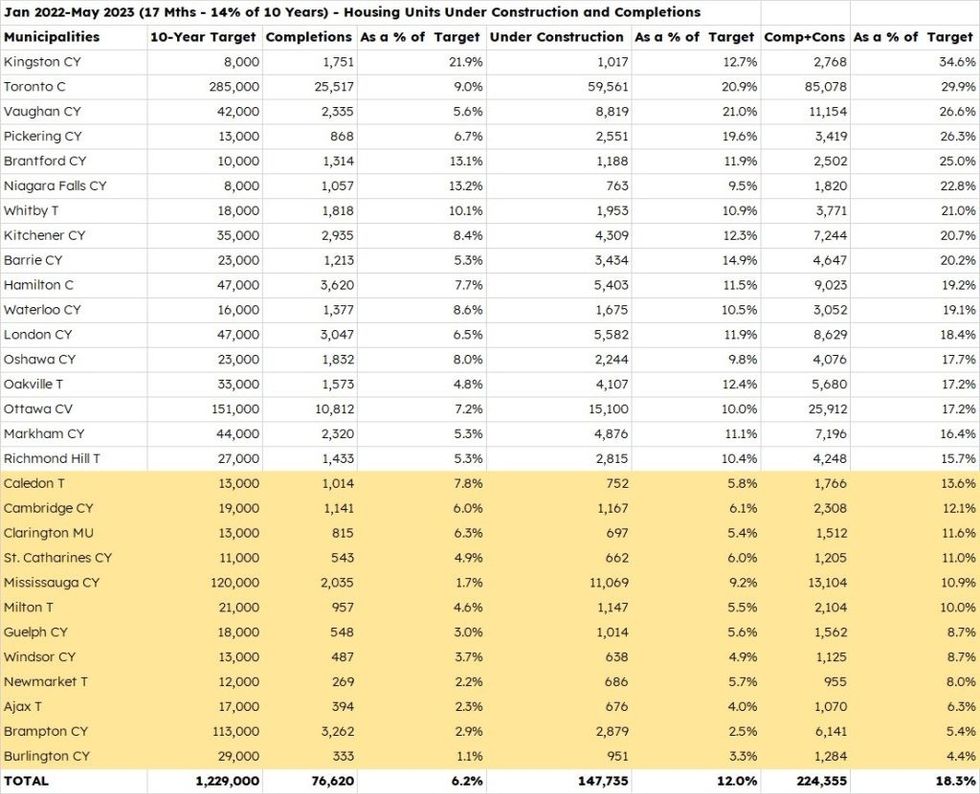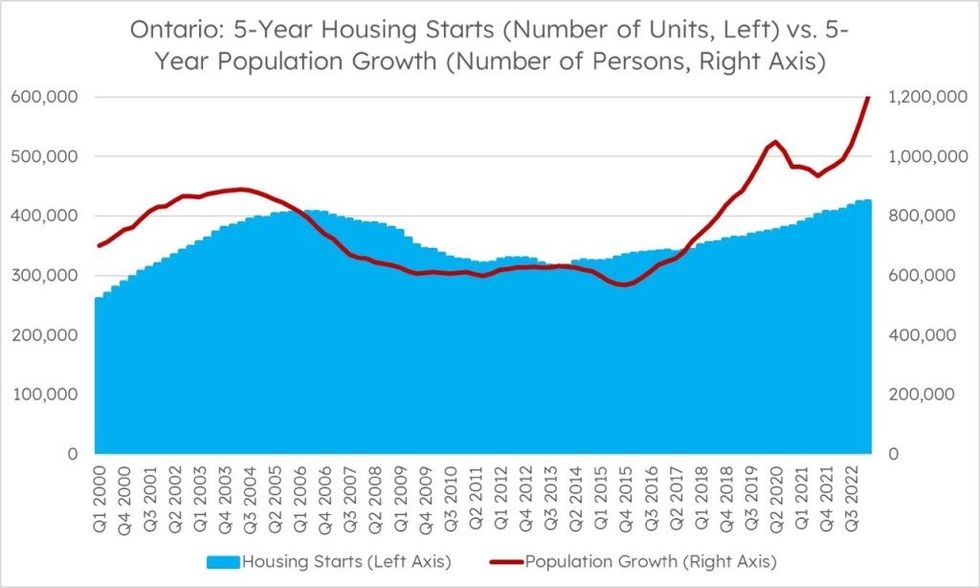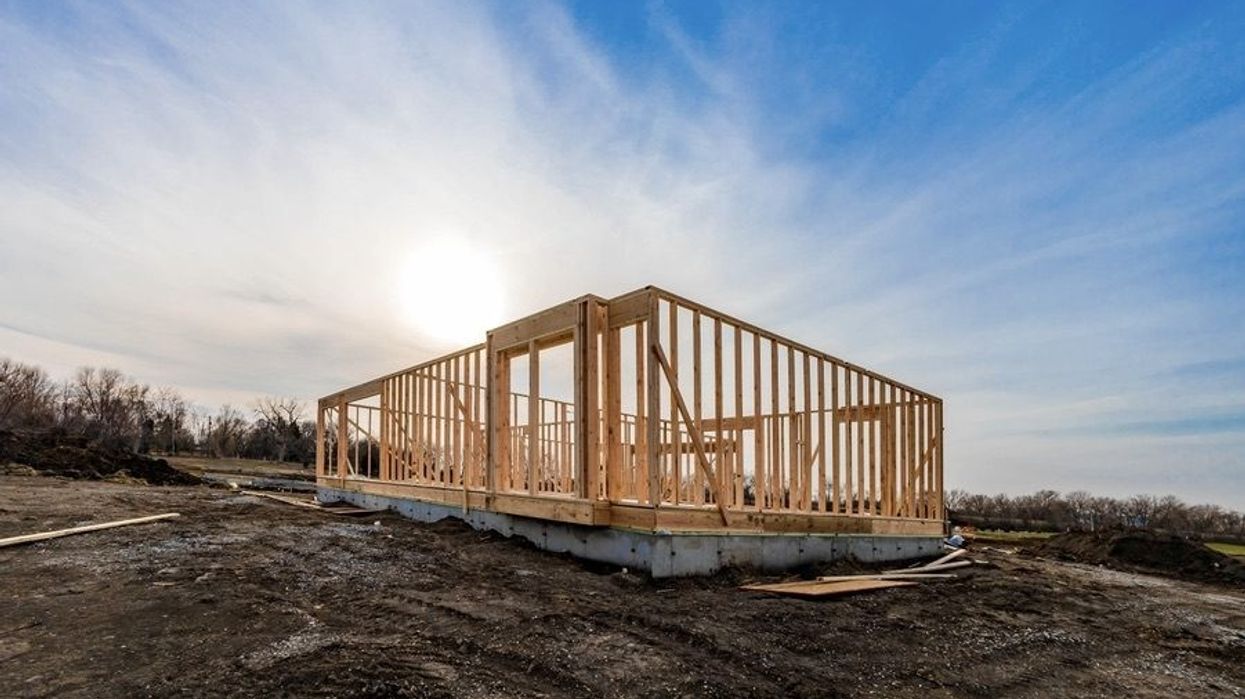In early 2022, the Government of Ontario very publicly pledged to build 1.5M new homes across the province by 2031.
Roughly a year-and-a-half in, many municipalities are already falling far behind the monthly targets that would indicate they're keeping pace with overall housing goals.
Economist and Assistant Professor at Ivey Business School Dr. Mike Moffatt has compiled recently-released data from the Canada Mortgage and Housing Corporation that shows a dozen cities already well off the necessary rate of production required to meet their provincially-imposed housing targets.
Moffatt's data presents housing completions and units under construction in 29 Ontario cities between January 2022 and May 2023, as well as each figure as a percentage of the municipality's 10-year goal.
And, while the 17-month timeframe puts Ontario 14% of the way through its 10-year target, 12 cities within the province are currently sitting under that 14% mark of progress toward their goal.
Based on the number of completions and units under construction, Burlington is just 4.4% of the way towards its goal of building some 29,000 new homes by 2031. Between January 2022 and May 2023, the city built just 333 new homes, and has fewer than 1,000 more currently under constriction.
Brampton is only slightly further along, at 5.4% of its goal, but it also has a higher overall target of 113,000 total homes. Ajax, meanwhile, is a meagre 6.3% of the way towards its goal of building 17,000 homes by 2031.
Of the 12 Ontario cities that are falling behind the province's overall pace -- which also include Newmarket (8.0%), Guelph (8.7%), and St. Catharines (11.0%) -- Mississauga has the highest housing target, at 120,000. As of May, it has completed just over 2,000 homes and has another 11,000 under construction, putting it 10.9% of the way towards its goal.
"We’re frustrated at the lack of progress across the province," Moffatt, who is also the Founding Director of the PLACE Centre, told STOREYS. "The data really isn’t moving in the right direction."
"It is certainly possible that the cities catch up -- we are only 14% of the way through this 10-year period, so there is still time -- but it's going to take a wartime-scale effort. We need to start making pretty drastic changes in the province, especially in the 905 areas that are particularly lagging."
In contrast to their suburban neighbours, some Ontario cities are making notable progress towards their goals.
Kingston is leading the way, having progressed 34.6% of the way towards its 8,000 housing target. Toronto, with its 285,000 housing goal, follows, at 29.9%. As of May, Toronto has completed more than 25,500 units, and has another 85,000 under construction. Vaughan (26.6%), Pickering (26.3%), and Brantford (25.0%) are also making good headway.

Despite having the most aggressive target in the province, Toronto's significant progress, in comparison to other municipalities, can be chalked up to policy and zoning changes, Moffatt said. The city has made a number of changes, such as permitting multiplexes and garden suites, in an effort to build more homes, faster.
As part of Toronto's newly-approved Housing Pledge, City Council plans to implement a number of other actions to meet the 285,000 target, including leveraging public land to increase the supply of housing, intensification of major growth areas, and preserving the existing rental housing stock.
But while Toronto is making changes, red tape still hinders progress in other municipalities.
"Ontario's zoning is particularly restrictive. Our development charges are quite high. Our taxes are quite high -- property taxes and things like GST that affect purpose-built rentals," Moffatt said.
"Overall, we tax and treat housing the same way we tax and treat cigarettes. We shouldn’t be surprised when it causes a reduction in either the production or consumption."
While there are some aggravating factors outside the government's control, like rising interest rates and labour shortages in the construction industry, Ontario remains a "tough regulatory environment to get things built in," due to considerable "regulatory and tax issues."
The pace of housing could be ramped up if more if the recommendations laid out by the Housing Affordability Task Force were implemented in more municipalities, Moffatt said, like permitting multiplexes in cities other than Toronto. While the controversial More Homes Built Faster Act seeks to make such changes, it comes at a cost for municipalities.
Municipal Affairs and Housing Minister Steve Clark was unavailable for an interview when contacted by STOREYS. In a statement, a spokesperson for the minister said that the government's actions are "still relatively new" and will "take time to be fully felt throughout the housing sector."
"We are determined to do what we can on the part of the province to ensure municipalities have the tools they need to meet their housing targets. That’s why we recently expanded strong mayor powers to mayors in 26 municipalities that have submitted a housing pledge," Victoria Podbielski, Press Secretary for Minister Clark, told STOREYS via email.
"In order to deliver our shared mandate of building 1.5M homes by 2031, we need our municipal partners to join us and help us achieve our shared goal of helping more Ontarians find a home that fits their needs and budgets."
Moffatt and Clark's office both agree that Ontario's housing supply crisis has been decades in the making, and will take a concerted effort to solve.
Part of the problem, Moffatt said, is rapid population growth in the absence of an increase in housing construction. The result of which will be a further decrease in affordability for homeowners and renters alike.
In the last five years, Ontario's population has grown by over 1.2M people; in the last 12 months, it has increased by over 500,000. The province recorded 96,080 housing starts in 2022, and 32,306 between January and May 2023.

"Last year in many cities in Southern Ontario rents on new leases were up 20% or more. My fear is that we may see that again this summer," Moffatt said.
"When interest rates flatline and start to creep back down, I do see home prices starting to shoot back up again, so long as we’re not building more homes and our population keeps growing."





















